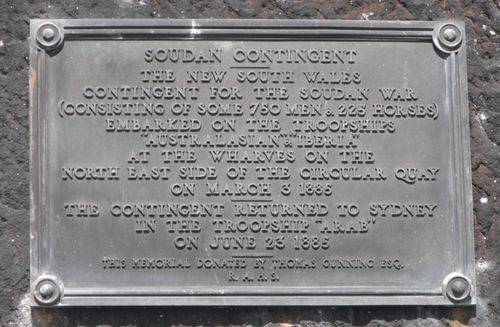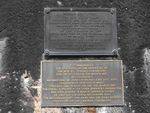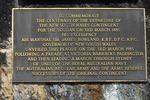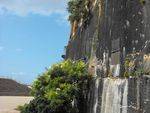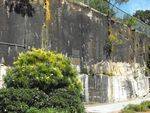
Soudan ContingentPrint Page 
Two plaques commemorate the involvement of volunteers from the Colony of New South Wales in the Sudan War. The original plaque was unveiled in 1952 with an additional plaque unveiled in 1985 to commemorate the centenary of the departure of the NSW Contingent for the Sudan.
In the early 1880s the British-backed Egyptian regime in the Sudan was threatened by an indigenous rebellion under the leadership of Muhammed Ahmed, known to his followers as the Mahdi. In 1883 the Egyptian government, with British acquiescence, sent an army south to crush the revolt. Instead of destroying the Mahdi`s forces, the Egyptians were soundly defeated, leaving their government with the problem of extricating the survivors. The British were persuaded to send General Charles Gordon, already a figure of heroic proportions in England, to consider the means by which the Egyptian troops could be safely withdrawn. Disregarding his instructions, Gordon sought instead to delay the evacuation and defeat the Mahdi; like the Egyptians, Gordon failed and found himself besieged in Khartoum. The popular general`s predicament stirred public opinion in England, leading to demands for an expeditionary force to be dispatched to his rescue.
The relief force was sent from Cairo in September 1884, but it was still fighting its way up the Nile when Gordon was killed in late January the following year. Gordon`s exploits were well known throughout the British Empire, and when the telegraph brought word of his death to New South Wales in February 1885 it was met with recriminations against the Liberal government led by William Gladstone for having failed to act in time. With news of Gordon`s death and the Canadian government`s offer of troops for the Sudan, the NSW government cabled London with its own offer.
To make its proposal more attractive, it offered to meet the contingent`s expenses; London accepted but stipulated that the contingent would be under British command. Similar offers from the other Australian colonies were declined.
On Saturday afternoon, June 21, 1952, the Royal Australian Historical Society Sydney, arranged the unveiling of a memorial plaque to the New South Wales Soudan Contingent of 1885 — the first Australian military force raised for service overseas.The memorial was unveiled by the General Officer Commanding Eastern Command, on the wall of the cliff at the Tarpeian Way, near the junction of East Circular Quay and Macquarlc Street, Sydney, at 3.30 p.m. in the presence of a large gathering of citizens. The memorial plaque bad been prepared as a result of a bequest by Mr. Thomas Gunning, of Mosman, Sydney, who died two years ago. East Circular Quay, on the harbour side of the State Government House, is adjacent to the point of embarkation of the troops in the year 1885. Mr. Gunning, who had left the money for the memorial, was an Englishman who settled in Australia at an early age. He served with Australian units in the South African War - (1899-1902) and during World War I (1914-18). The spelling of "Soudan" in use at the period of the departure of the contingent in 1885 was retained on the memorial in preference to the present day spelling— "Sudan."
Lieut-General T. R Berryman, G.O.C. Eastern Command at Victoria Barracks, Sydney is the lineal successor to Colonel John Soame Richardson, who held the rank of Military Commandant in New South Wales in 1885 and who was in command of the Soudan Contingent. Major-General the Reverend C. A. Osborne, who dedicated the memorial plaque after its unveiling on June 21 last, served with distinction as a combatant officer in India and on other battle fronts. Major the Honorable C. E. Martin, the Attorney General of New South Wales, who addressed the gathering after the unveiling and dedication is the lineal successor of the Honorable William Bede Dalley, who as Attorney-General in 1885, made the offer of these soldiers to assist in the maintenance of British interests in the Sudan as soon as he received information of the murder of General Gordon at Khartum on January 26, 1885.
Townsville Daily Bulletin (Qld), 11 July 1952.
Location
| Address: | Macquarie Street, Tarpeian Way, near Sydney Opera House forecourt, Sydney, 2000 |
|---|---|
| State: | NSW |
| Area: | AUS |
| GPS Coordinates: | Lat: -33.858806 Long: 151.213858 Note: GPS Coordinates are approximate. |
Details
| Monument Type: | Plaque |
|---|---|
| Monument Theme: | Conflict |
| Sub-Theme: | Colonial |
| Actual Event Start Date: | 03-March-1885 |
| Actual Event End Date: | 23-June-1885 |
| Link: | http://www.warmemorialsregister.nsw… |
Dedication
| Actual Monument Dedication Date: | Saturday 21st June, 1952 |
|---|
Plaque :
Soudan Contingent
The New South Wales Contingent for the Soudan War (consisting of some 750 men and 225 horses) embarked on the troopships "Australasian" &"Iberia" at the wharves on the north east side of the Circular Quay on March 3 1885.
The Contingent returned to Sydney in the troopship "Arab" on June 23 1885.
This memorial donated by Thomas Gunning Esq. R.A.H.S.
Plaque :
To commemorate the centenary of the departure of the New South Wales Contingent for the Soudan on 3rd March 1885
His Excellency Air Marshall Sir James Rowland KBE DFC AFC Governor of New South Wales unveiled this plaque on 3rd March 1985 following a parade at Victoria Barracks Paddington and then leading a march through Sydney of units of the Royal Australian Navy, the Australian Regular Army and the Army Reserve, successors of the original vontingent.



